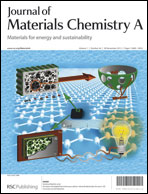Highly permeable chemically modified PIM-1/Matrimid membranes for green hydrogen purification
Abstract
Polymers of intrinsic microporosity, e.g. PIM-1, are attractive materials for gas separation and energy development, which is ascribed mainly to their superior permeability. The H2 and CO2 permeability of PIM-1 is about 1300–4000 Barrer and 3000–8000 Barrer, respectively. However, it has a relatively low H2/CO2 selectivity of 0.4–0.8. Different from the previous UV rearrangement approach, for the first time we report here a viable method to tune the intrinsic properties of PIM-1 blend membranes from being CO2-selective to H2-selective via blending with Matrimid and subsequent cross-linking the mixed matrix membrane with diamines at room temperature. The ideal H2/CO2 selectivity of the membrane after modification by 2 h triethylenetetramine (TETA) improved dramatically from 0.4–0.8 to 9.6, with a H2 permeability of 395 Barrer. The modified membranes also show exceptional separation performance, surpassing the present upper bound for H2/CO2, H2/N2, H2/CH4 and O2/N2 separations. Positron annihilation lifetime spectroscopy (PALS) and Field emission scanning electron microscopy (FESEM) revealed that the diamine cross-linking successfully alters the membrane morphology from a dense to a composite structure. The X-ray diffraction (XRD) analysis and sorption data confirmed that the modified membrane has a smaller d-spacing and a decrease in the diffusivity coefficient. Our results also affirmed that the spatial structure, rather than the pKa value, of the diamine is the prevailing factor which governs the reactivity of diamines towards the PIM-1/Matrimid membrane due to the low concentration of cross-linkable polyimides distributing randomly in the polymer matrix. The fundamentals and knowledge gained throughout this study may facilitate the development of polymeric membranes for green H2 enrichment processes.


 Please wait while we load your content...
Please wait while we load your content...